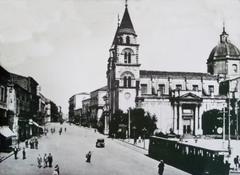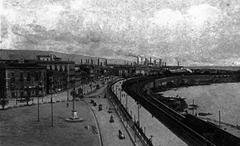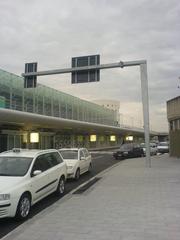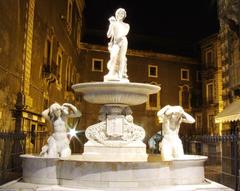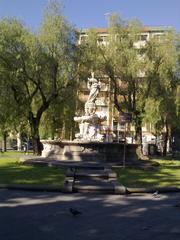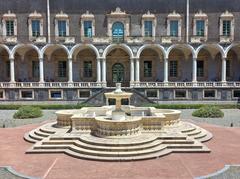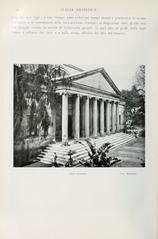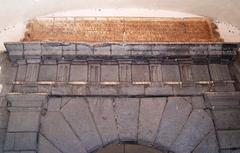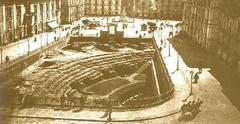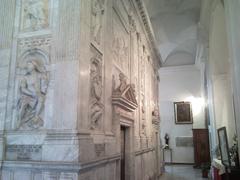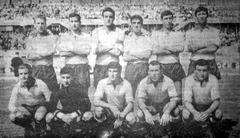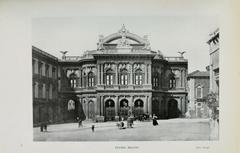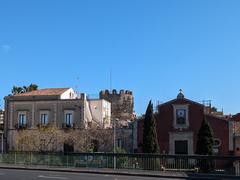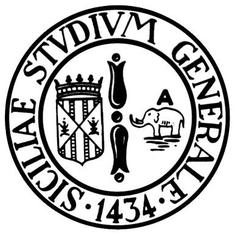
Piazza del Duomo Catania: Visiting Hours, Tickets, and Complete Visitor Guide
Date: 04/07/2025
Introduction
Piazza del Duomo in Catania is the pulsating heart of Sicily’s second-largest city—a place where history, culture, and daily life converge. This iconic square, renowned for its stunning Sicilian Baroque architecture, is home to some of Catania’s most treasured landmarks, including the Cattedrale di Sant’Agata, the whimsical Fontana dell’Elefante, and the stately Palazzo degli Elefanti. Recognized as a UNESCO World Heritage Site, Piazza del Duomo invites visitors to explore centuries of resilience and artistry, from ancient Roman foundations to vibrant present-day festivals (Italia.it; UNESCO).
This detailed guide provides everything you need for a memorable visit: historical context, practical information on opening hours and tickets, accessibility advice, event highlights, local tips, and answers to common questions. Whether you’re a history enthusiast, architecture aficionado, or cultural traveler, discover why Piazza del Duomo is the essential gateway to Catania’s soul (TripVenture; Audiala).
Table of Contents
- Historical Overview
- Architectural Landmarks
- Cultural Significance & Festivals
- Visiting Information
- Guided Tours & Special Events
- Photography Spots & Nearby Attractions
- FAQs
- Summary and Visitor Tips
- References
Historical Overview
Ancient and Medieval Origins
Piazza del Duomo’s layered history begins in the Roman era, when the site housed the Thermae of Achilles—remnants of which are still visible beneath the cathedral (Cheerful Trails). The square’s position at the intersection of Catania’s main streets made it a natural center for both civic and spiritual activity.
Following the Norman conquest of Sicily in the 11th century, Roger I of Altavilla commissioned the original cathedral as both a church and fortress (1094), building atop the ancient baths. The structure’s defensive features reflected the turbulent medieval period, marked by natural disasters and frequent attacks (Italia.it).
The 1693 Earthquake and Baroque Transformation
The catastrophic earthquake of 1693 devastated Catania, reducing much of the medieval city, including its piazza and cathedral, to rubble (Visit Catania). This tragedy catalyzed a grand urban renewal, led by architect Giovanni Battista Vaccarini, who reimagined the square in sumptuous Sicilian Baroque style. The redesign emphasized symmetry, grandeur, and the dramatic interplay of light and shadow, with the piazza as the nucleus from which Catania’s principal streets radiate (EAA).
Architectural Landmarks
Cattedrale di Sant’Agata (Catania Cathedral)
The reconstructed Cathedral of Saint Agatha is the centerpiece of the piazza. Its facade—an exquisite example of Sicilian Baroque—features 14 granite columns and intricate marble work, while the preserved Norman transept and apses evoke its layered past. The cathedral houses the relics of Saint Agatha, the city’s beloved patron, as well as the tomb of composer Vincenzo Bellini (Italia.it; thecrazytourist.com). Step inside to admire the 17th-century frescoes, ornate chapels, and the marble portal.
Visiting Hours: Generally open daily from 7:30 AM to 7:00 PM, with possible variations during religious services or festivals.
Accessibility: Ramps provide wheelchair access at the main entrance.
Fontana dell’Elefante (Elephant Fountain)
At the heart of the square is the Fontana dell’Elefante—a black lava stone elephant, “Liotru,” surmounted by an Egyptian obelisk. Designed by Vaccarini in 1736, the elephant is both a symbol of Catania’s identity and a legendary protector against Mount Etna’s eruptions (EAA; Etna Experience). The fountain’s playful spirit and rich symbolism make it a must-see and a favorite photo spot.
Palazzo degli Elefanti & Other Baroque Gems
Flanking the square are other Baroque masterpieces:
- Palazzo degli Elefanti (City Hall): Completed in 1739, this elegant structure features arched balconies and houses municipal offices (theorangebackpack.nl).
- Palazzo dei Chierici & Porta Uzeda: Forming the square’s southern boundary and linking to the city walls.
- Fontana dell’Amenano: A graceful marble fountain marking the spot where the Amenano River surfaces briefly before vanishing underground (nomads-travel-guide.com).
Cultural Significance & Festivals
Piazza del Duomo is the heartbeat of Catania’s civic, religious, and social life. The annual Feast of Saint Agatha in February is among Italy’s largest religious festivals, drawing nearly a million visitors for processions, fireworks, and traditional music (Comune di Catania). The piazza is also a daily gathering place for locals and tourists, with its lively cafés, street performers, and proximity to the famous La Pescheria fish market (TripVenture).
Visiting Information
Opening Hours
- Piazza del Duomo: Open 24/7 as a public space.
- Cattedrale di Sant’Agata: Open daily from 7:30 AM to 7:00 PM (hours may vary on holidays and during special events).
- Other Landmarks: Most outdoor sites are accessible at all times; for museums or exhibitions, check individual opening hours.
Tickets & Admission
- Piazza del Duomo: Free access.
- Cathedral: Free entry; donations welcome. Some special exhibitions or guided tours may require a ticket.
- Guided Tours: Available from €10–€25, often including the cathedral, piazza, and nearby sites. Advance booking is recommended during peak seasons.
Accessibility
The square is flat and paved, offering wheelchair access throughout, with ramps at key entrances. Some cobblestone areas may be uneven, so extra care is advised.
Travel Tips
- Best Time to Visit: Early morning or late afternoon for softer light and fewer crowds.
- Dress Code: Modest attire is recommended for cathedral visits (shoulders and knees covered).
- Dining: Cafés and trattorias around the square serve local specialties—try a traditional granita or cannoli.
- Getting There: Central location, walkable from Catania’s train station or accessible by local buses. Parking in the city center is limited.
Guided Tours & Special Events
Guided walking tours depart regularly from Piazza del Duomo, offering insights into its history, legends, and architecture. During the Festa di Sant’Agata and other festivals, special themed tours are available. The piazza also hosts concerts, open-air markets, and art events throughout the year (MapTurners).
Photography Spots & Nearby Attractions
- Fontana dell’Elefante: Iconic at sunrise or sunset.
- Cathedral Facade: Best captured from the piazza’s western edge.
- Amenano Fountain: Beautiful marble details and water “veil” effect.
- Nearby:
- La Pescheria Fish Market: For vibrant street scenes and local cuisine.
- Via Etnea: Shopping and views of Mount Etna.
- Via Crociferi: Renowned for Baroque churches and nighttime ambiance.
Frequently Asked Questions (FAQ)
Q: Is there an entrance fee to visit Piazza del Duomo or the cathedral?
A: No, both are free to enter. Some exhibitions or guided tours may have a fee.
Q: What are the opening hours for the cathedral?
A: Typically 7:30 AM–7:00 PM daily, but check ahead for variations on holidays.
Q: Is the piazza wheelchair accessible?
A: Yes, with ramps at key sites. Some cobblestone areas may be uneven.
Q: Are guided tours available?
A: Yes, in multiple languages, starting from €10–€25 depending on duration and sites included.
Q: When is the best time to visit?
A: Early morning or late afternoon, outside major festivals, for fewer crowds and better light.
Summary and Visitor Tips
Piazza del Duomo is a living testament to Catania’s layered history and vibrant culture. From Roman baths beneath your feet to the grandeur of Baroque facades above, every corner tells a story. The square’s accessibility, free entry, and central location make it ideal for all travelers. Enhance your visit with a guided tour for deeper historical context, and don’t miss the bustling La Pescheria or a stroll along Via Etnea.
To maximize your experience, check event calendars, dress modestly for religious sites, and visit during off-peak hours for tranquility. For up-to-date information, downloadable audio guides, and digital maps, consider the Audiala app.
References
- (Cheerful Trails)
- (Italia.it)
- (Etna Experience)
- (Comune di Catania)
- (ItalyScapes)
- (UNESCO)
- (Urban Splatter)
- (theorangebackpack.nl)
- (Voyage Tips)
- (The Passport Couple)
- (Audiala)
- (TripVenture)
- (EAA)
- (MapTurners)
For more travel tips, updated guides, and event news, download the Audiala app or visit our related articles and social channels.


